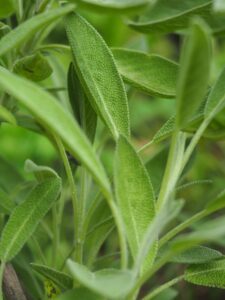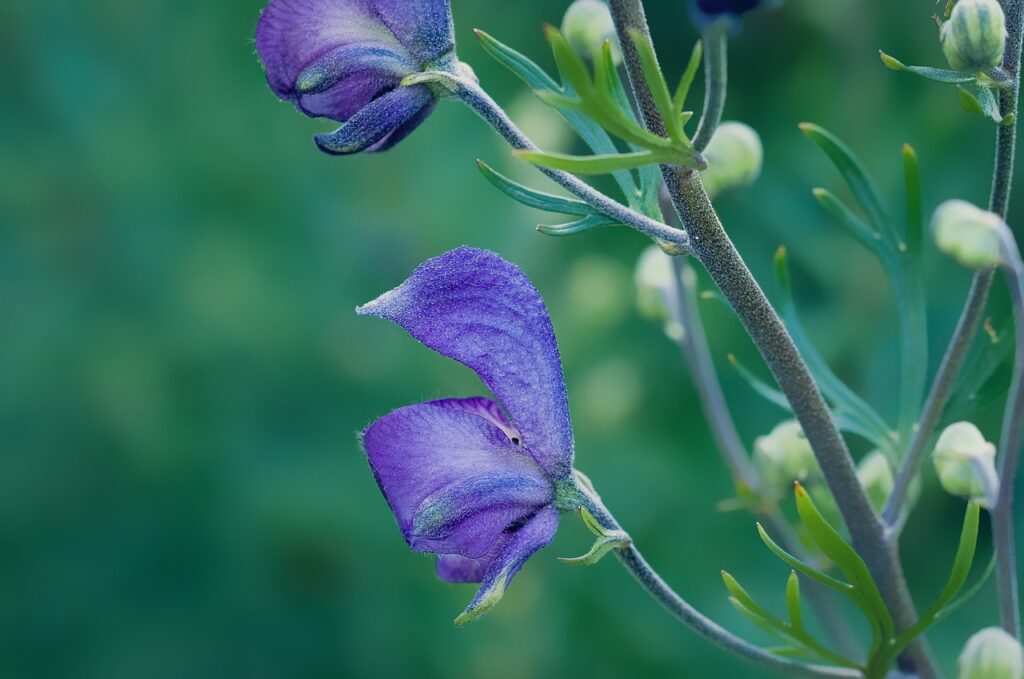Sage

Salvia officinalis
Lamiaceae Family
From the same family bringing you mint, rosemary, thyme and lavender to name a few, sage has multiple qualities and attributes that have been recognised and utilised for millennia.
While at least several varieties are attributable to different roles and uses, for many-a century, common sage or garden sage (aka S. officinalis), which this write up focuses on, brings with it not only a beautiful edible and medicinal, ornamental plant of greyish leaves and blusih purple flowers, but also serves up a pleasant tasting herbal tea. Privy to numerous other applications including acting not only as a cleaning agent, in cosmetics, and with ceremonious applications, much of its magic can be attributed to the essential oils that are secreted from spherical glandular structures, known as trichomes on the leaves. It also plays host to an array of garden benefits.
Garden magic
Sage is a comparatively low maintenance perennial schrublet, enjoying full sun and mostly dry to somewhat moist soil conditions. It is relatively drought tolerant once established. Self-seeding, it typically lives three or four years before its quality descends. Sage can be planted during winter, however it is thought to establish itself best planted in the spring, and through summer months, or at least after the final frost. Making an ideal companion plant for cabbage (and basically all Brassica family members) and carrots, sage is a key companion plant with rosemary, reciprocally stimulating one anothers’ growth, health and productivity. Sage is also an insect attractant to the like of butterflies, bees and more, and acts as a repellent to various garden pests. It can be propagated both via cuttings and seeds, though the seeds are associated with low germination rates and therefore extra seeds may be required for this situation. While generally requiring little maintenance, sage enjoys a bit of pruning-back when becoming a bit sparse and twiggy. Harvest the leaves all year round and use fresh for a few days, or store dried in air tight dimly lit conditions for many months. The flowers can be harvested mid through late Summer, and into early Autumn, however it can be variable according to climatic region.

Wild Sage
Origins
A plant native to Mediterranean areas, sage has since travelled, settling across virtually all corners of the globe. Its name is Latin for ‘salvere’, meaning “to be of good health; to save, or to cure”, providing insight into its reputation for being a very benevolent, healing and life-affirming plant. Sage’s name also means ‘saviour’, illustrating historical reverence, with our ancestors considering it sacred, and gathering and using it during ceremony. Sage sticks are still burned ritualistically as a tool for purifying the air and energies within the immediate environment. Sage was valued so highly by the Chinese that they would offer three times the amount of their tea in exchange for sage. It was used as a component of Four Thieves Vinegar during the Middle Ages – a concoction devised to ward off Black Death.

Garden sage with a well known beneficial insect
Medicinally
Traditionally, sage has been used to treat a number of ailments by virtue of somewhat tonifying, astringing and stimulating aromatic qualities uniting within its leaves. From indigestion, to colds,
coughs or other infections and inflammatory conditions of the mouth, tongue and throat, and extremities, sage is also indicated for menopausal hot flushes, and other conditions of extreme sweating (hyperhidrosis). Thankfully, due to a high mineral content, sage can help to replenish depleted mineral stores subsequent to heavy sweating. It has additionally been used as a remedy for low mood, attention deficits, nervous debility, exhaustion, PMS, uterine pain and excessive blood loss during menstruation.
Multiple active constituents are contained in the leaves, including tannins, resins, saponins and bitter substances. Many key therapeutic qualities however, derive from the essential oils, including thujone, which chiefly confers sage’s anti-microbial and antiseptic endowments, inhibiting the growth of a host of micro-organisms including bacteria, viruses and fungi. Sage also contains the oil cineole (reknown from Eucalypts), offering further anti-microbial activities, alongside decongestive, analgesic and anti-inflammatory properties; and camphor, which provides further analgesia.
Recent studies have demonstrated sage to possess cognition and memory enhancing effects. These may be attributable to the cineole, alongside thujone, in addition to another key therapeutic constituent called rosmarinic acid (RA). RA is an antioxidant shown to not only prevent vascular damage leading to dementia and cognitive decline, but also to exert further anti-inflammatory and analgesic properties. Therefore it demonstrats not only potential application in allergy prevention, but also in Alzheimer’s and other forms of dementia, as well learning disorders. It also contains oestrogenic substances known as phytosterols. It is these that presumably contribute to its application in menopausal hot flushes, and its ability to suppress mammary secretions.
Nutritionally
Sage leaves contain vitamins K, C and A, and is a great source of B vitamins and minerals including potassium, calcium, magnesium, iron, manganese, copper and zinc.
In the kitchen
Both the leaves and flowers are edible. Leaves are typically cooked, however young leaves may be enjoyed raw, making a great accompaniment to nearly all savoury dishes. The flowers make a fantastic garnish for salads, cakes or other edible flower-power creations (i.e. frozen in ice cubes). Sage is thought especially effective at aiding digestion of fats and oils, which may not surprise you that foods rich in these are generally best accompanied by sage. The fresh plant is milder in taste than the dried form, as are the purple and varigated varieties. Generally sage is considered a herb used best on its own.
Dosing
1 to 2 teaspoons of dried leaf may be taken as a tea/infusion between one and eight times each day, or 3 to 12 grams of dried herb per day.

Herbal Tea with mint, sage and fennel flavors
Cautionary wisdom and common sense
While culinary –wise, or as tea, sage is generally harmless, taking concentrated forms such as essential oils or alcohol extracts should be avoided, or only taken under professional supervision for any lengthy period. This is especially due to the thujone, which is toxic in high amounts, with a tendency to accumulate in our liver and kidneys, possibly producing symptoms of poisoning when taken in excess. Also, thujone can cause convulsions in people with epilepsy.
Sage was traditionally used as a form of birth control, as well as a uterine stimulant (partus prep), and is therefore best avoided during pregnancy or in those wishing to conceive. It should also be avoided during lactation, because by virtue of its astringing and drying effects, it reduces and slows breast milk production and flow.
Some further herb for thought
There you have it, or at least a teaser. Time to add sage to your ‘to plant’ list, one that may be particularly handy to have nearby during cold and flu season, and hayfever season.
It is interesting to note that many of the medicinal qualities of sage (and of generally all medicinal plants) come about by virtue of the active phyto-constituents, which appear and work together, in synergy to bring about their effect. Operating at a gentle, but targeted level, accompanying milder actions and activities work around the scenes supporting surrounding tissues and organs to bring the body closer to homeostasis, or back into balance. Perhaps it is this delicate balance of actions that our ancients were referring to when they heralded sage as saviour?! Something to ponder about amidst the garden greenery.
Please don’t forget to see your qualified health care practitioner with any health care concerns. Wishing you good health and vitality, from your garden to your plate, and medicine chest.















